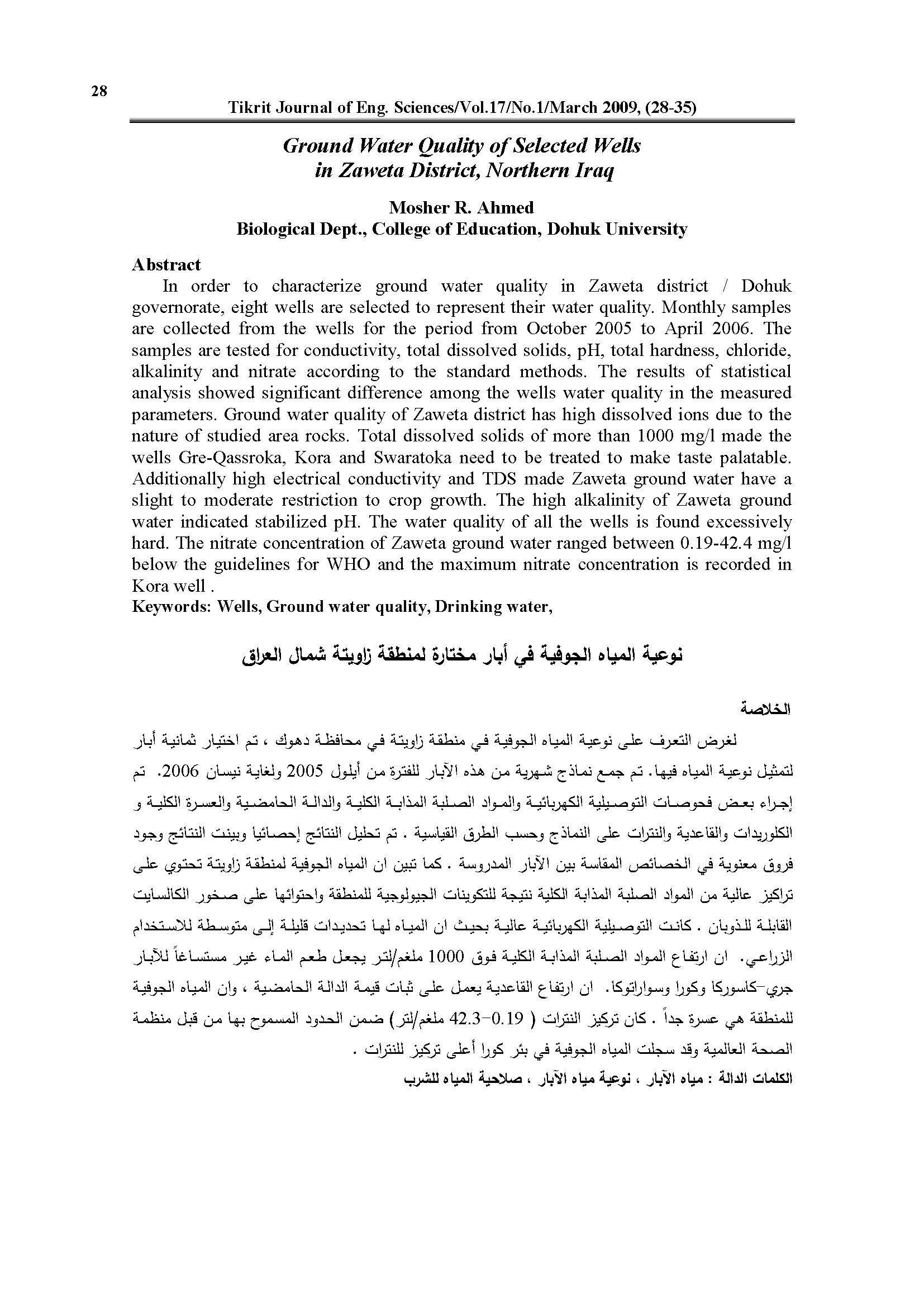Ground Water Quality of Selected Wells in Zaweta District, Northern Iraq
Main Article Content
Abstract
In order to characterize ground water quality in Zaweta district / Dohuk governorate, eight wells are selected to represent their water quality. Monthly samples are collected from the wells for the period from October 2005 to April 2006. The samples are tested for conductivity, total dissolved solids, pH, total hardness, chloride, alkalinity and nitrate according to the standard methods. The results of statistical analysis showed significant difference among the wells water quality in the measured parameters. Ground water quality of Zaweta district has high dissolved ions due to the nature of studied area rocks. Total dissolved solids of more than 1000 mg/l made the wells Gre-Qassroka, Kora and Swaratoka need to be treated to make taste palatable. Additionally high electrical conductivity and TDS made Zaweta ground water have a slight to moderate restriction to crop growth. The high alkalinity of Zaweta ground water indicated stabilized pH. The water quality of all the wells is found excessively hard. The nitrate concentration of Zaweta ground water ranged between 0.19-42.4 mg/l below the guidelines for WHO and the maximum nitrate concentration is recorded in Kora well.
Metrics
Article Details

This work is licensed under a Creative Commons Attribution 4.0 International License.
THIS IS AN OPEN ACCESS ARTICLE UNDER THE CC BY LICENSE http://creativecommons.org/licenses/by/4.0/
Plaudit
References
Al-Layla M.A., Al-Rawi S.M. and Al-Kawaz H.A. (1990). Physico-chemical evaluation of groundwater around Mosul dam lake used for drinking and domestic purposes. 2nd Scientific Conference of Mosul Dams and Water Resources Research Center, Mosul Univ. 18-20 March 1990.
Habib H.R., Al-Saigh N.H. and Hassan Z.M. (1990). Geochemistry of Underground water in Erbil city. 2nd Scientific Conference of Mosul Dams and Water Resources Research Center, Mosul Univ. 18-20 March 1990.
Al-Rawi S.M., Al-Azzo S.I. and Abbawi S.A. (1990). Hyrogeo-chemical evaluation of groundwater in some parts of Mosul city and suitability for irrigation. 2nd Scientific Conference of Mosul Dams and Water Resources Research Center, Mosul Univ. 18-20 March 1990.
Abdulhussein F. M. (2002). Hydrogeology of groundwater of Makhmour plain. M.Sc. Thesis, Baghdad University.
Shihab A.S. and Hashim A. (2006). Cluster analysis classification of groundwater quality in wells within and around Mosul city/Iraq. Journal of Environmental Hydrology, Vol. 14: 1-11.
Ahmed M.R., Shihab, A.S. and Al-Rawi S.M. (2007). Water quality of Selected Springs in Zaweta District, Northern Iraq: A Comparative Study. 1st Conference of Environment and Pollution Control Researches Center, 5-6 June 2007, Mosul University, Mosul, Iraq.
Shihab, A.S. (2007). Arrangement of selected wells for irrigation use according to water quality index in Ninevah Governorate. 1st Conference of Environment and Pollution Control Researches Center, 5-6 June 2007, Mosul University, Mosul, Iraq.
APHA, AWWA and WPCF. Standard Methods for the Examination of Water and Wastewater. 18th ed., APHA, Washington, DC, 1992.
Twort, A.C., Ratnayaka D.D. and Brandt M.J. Water supply. 5th ed., Butterworth-Heinemann, Oxford, 2001.
Al-Safawi A.Y.T. (2007). Study the suitability of Al-Qonisa/ Hmaidat ground to agricultural use. J Edu Sci, Special issue for the 1st Conference of Biology, Sep 2007 (In Arabic).
Food and Agriculture Organization (1994). Water quality for agriculture. Ayers R.S. and Westcot D.W. (Ed.). FAO Irrigation and Drainage paper, Reprinted 1994, Rome.
Al-Safawi, A.Y.T., Ibrahim, Dh.A, Al-Safawi, N.T. (2002). Study of water quality of Al-Qonesa village and its suitability for domestic use. J Edu Sci 14(2): 19-28.
World Health Organization (2004). WHO guidelines for drinking
water quality. 3rd ed. Vol. 1, Recommendations, Printed in China by Sun Fung.





